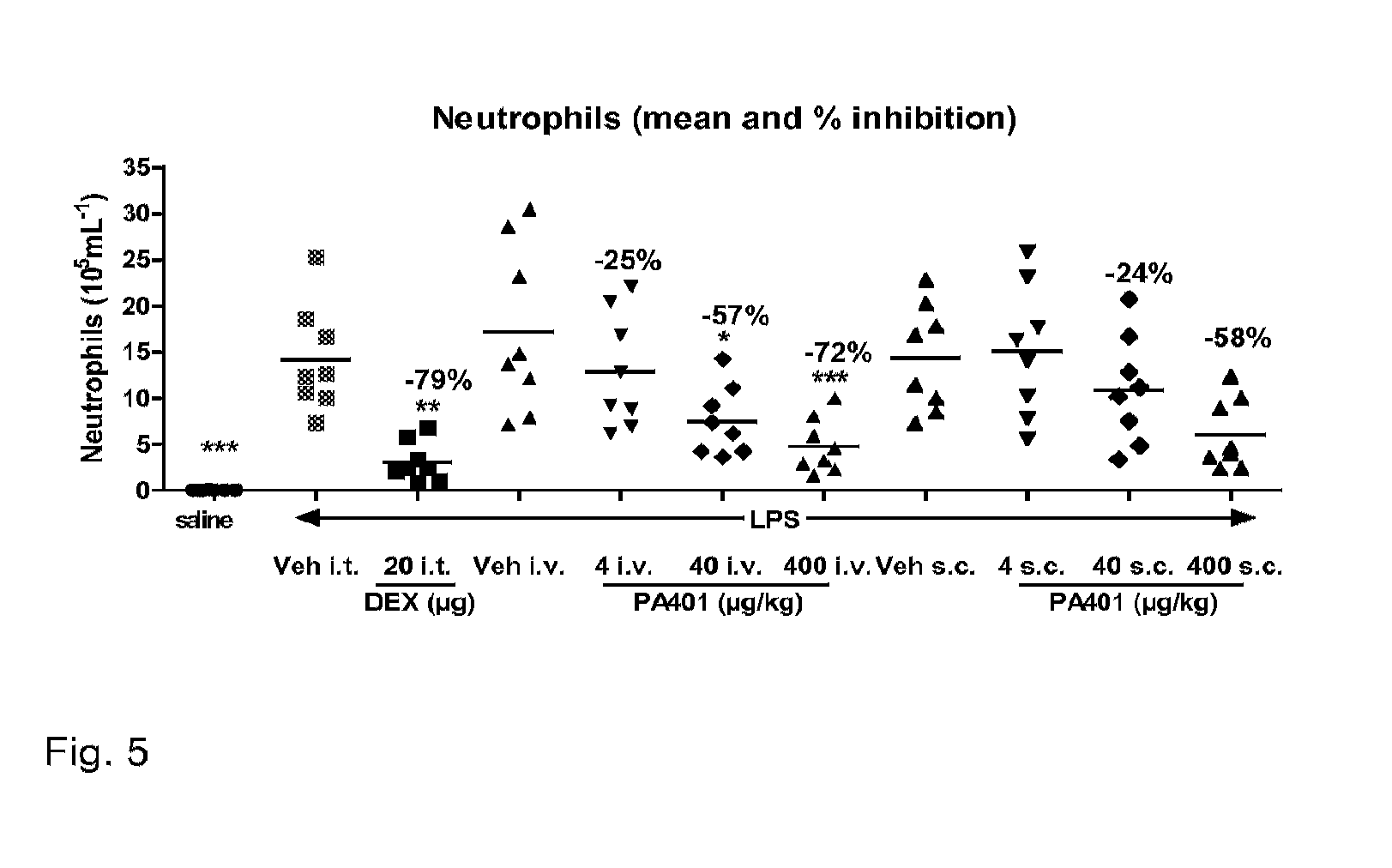Composition for treatment of cxcl8-mediated lung inflammation
a technology of cxcl8 and composition, applied in the direction of peptide/protein ingredients, peptide sources, immunological disorders, etc., can solve the problems of largely ineffective application of traditional glucocortico-steroids
- Summary
- Abstract
- Description
- Claims
- Application Information
AI Technical Summary
Benefits of technology
Problems solved by technology
Method used
Image
Examples
example 1
[0088]PA401 Effects on LPS-Induced Acute Lung Inflammation Models in Mice.
[0089]A variety of stimuli induce neutrophil migration into the lung. Among the most frequently used and best characterized inflammatory inducer is the endotoxin of Gram-negative bacteria (lipopolysaccharide: LPS).
[0090]LPS instilled intranasal, or aerosolized induces a dose and time dependent neutrophil infiltration in the lung vasculature, interstitium and BAL (Reutershan et al. 2005), with peak levels reached between 4-8 hours post challenge, and remaining significantly above baseline for up to 24 hours in mice.
[0091]The LPS dose administered varies based on the LPS serotype, the method of application and the strain of the mice used, with significant BAL neutrophilia reported for doses of LPS as low as 0.1 μg / mouse and up to 800 μg / mouse.
[0092]LPS inhalation is able to induce lung neutrophil infiltration across species (e.g. mice and rats, Chapman et al.2007; guinea pigs; Wu et al. 2002; rabbits, Smith et a...
example 2
[0095]A second study was performed using a slightly different model, which imply a different mouse strain and gender (male Balb / c instead of C57BL / 6) a different LPS strain and serotype (Salmonella enterica instead of E. Coli) and a different LPS administration (aerosol—3.5 mg / 7 mL over 30 min—instead of intranasal). PA401 doses of 4, 40 and 400 μg / kg were administered either by s.c. or i.v. route at t=−5 and t=+3 h from LPS exposure. BAL total and differential cell count were evaluated at t=8 h, a later time point compared to the previous study.
[0096]Saline aerosolized mice and mice receiving an intra tracheal administration of Dexamethasone (20 μg / 20 ∥l / mouse at t=−1 h) were used as control.
[0097]Also in this case PA401 induced a highly significant reduction in the number of total cells in the BAL (FIG. 4), due to reduction in neutrophils count (FIG. 5). The activity of PA401 was more significant when administered by intravenous than by subcutaneous route, reaching the same inhibi...
example 3
[0099]PA401 Effects in an Acute Model of Cigarette Smoke Induced Lung Inflammation.
[0100]Acute exposure of mice to cigarette smoke leads to lung responses that, at least in part, mimic the lung inflammation observed in COPD patients. Different mouse strains present variable degree of lung inflammation following acute cigarette smoke exposure (Guerrassimov et al. 2004, Vlahos et al. 2006). This genetic variability in the response in mice appears quite representative of the variable susceptibility to develop COPD among human smokers, and therefore this model is considered the most relevant to model the human pathology.
[0101]Lung inflammation was induced in C57BL / 6J female mice (a susceptible strain) by exposure to cigarette smoke of 4 to 6 cigarette over a four-day period. Dose response activity of subcutaneous PA401 treatment at the doses of 4, 40 and 400 μg / kg administered at t=+30 min and t=+6 h from smoke exposure, on cell infiltrates on bronchoalveolar lavages was evaluated 24 h ...
PUM
| Property | Measurement | Unit |
|---|---|---|
| Fraction | aaaaa | aaaaa |
| Affinity | aaaaa | aaaaa |
Abstract
Description
Claims
Application Information
 Login to View More
Login to View More - R&D
- Intellectual Property
- Life Sciences
- Materials
- Tech Scout
- Unparalleled Data Quality
- Higher Quality Content
- 60% Fewer Hallucinations
Browse by: Latest US Patents, China's latest patents, Technical Efficacy Thesaurus, Application Domain, Technology Topic, Popular Technical Reports.
© 2025 PatSnap. All rights reserved.Legal|Privacy policy|Modern Slavery Act Transparency Statement|Sitemap|About US| Contact US: help@patsnap.com



